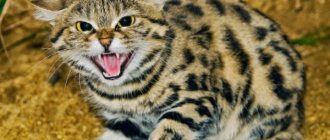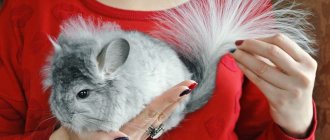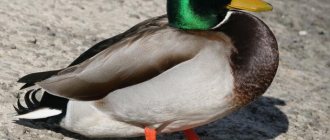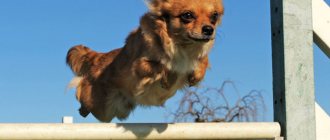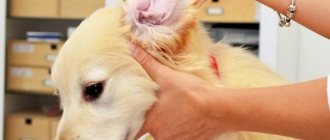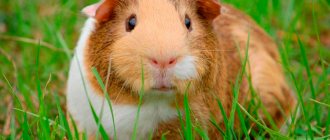Long-lived among rodents
Properly organized care and a nutritious diet will allow your furry rodent to become part of your family for a long time. Chinchillas, unlike other domestic rodents, can live up to 20 years! In the wild, when the animal itself has to fight for its existence, the average life expectancy does not exceed 12 years. In the wild, a chinchilla does not live long because with age, motor activity decreases and it becomes difficult to hide from predators.
The maximum lifespan of a domestic chinchilla is 25 years. Even more than a dog. But only a few rodents reach such a respectable age. On average, in a comfortable home environment, surrounded by love and affection, they live to be 15-17 years old. These rodents reach sexual maturity by 7 months. A female can bear offspring 2-3 times a year.
How many years do chinchillas live?
Chinchillas differ from other rodents in their longevity: in favorable conditions, this animal can survive up to 30 years. Moreover, life expectancy in the wild and at home can be quite different: as a rule, in nature such an animal lives half as long as in favorable conditions next to a person.
Life in nature
In the wild, a chinchilla lives on average up to 10-12 years. As a rule, closer to the eleventh or twelfth year, the animal becomes less agile and fast, as a result of which it can easily fall into the clutches of predators.
Home conditions
Life expectancy in captivity directly depends on the conditions under which the animal is kept. With proper care and the right diet, a chinchilla can live about 25-30 years.
However, in unfavorable and uncomfortable conditions, which consist primarily of an incorrect diet, neglect to keep the animal’s cage clean, as well as poorly thought-out organization of the home, the pet is unlikely to overcome the eight-year mark.
Chinchillas have a specific life cycle.
How to extend the life of a chinchilla in captivity?
When purchasing any pet, especially if there are children in the family, the question arises about its life expectancy. The sudden death of a pet can traumatize the fragile nervous system of children. Therefore, parents should study in advance how chinchillas live in captivity and the features of caring for them, so that the new family member feels good for a long period.
First, find out all the details of the place where you are buying the animal. If you are given a sick chinchilla or a rodent with a genetic disease (which you won’t notice right away), the animal will not last long. A healthy chinchilla needs to create almost ideal living conditions at home, paying special attention to its nutrition.
Choose a spacious chinchilla cage and keep the pet’s house clean. General cleaning must be done once a week. Walking on the floor will be beneficial for a chinchilla, but all dangerous objects that it can chew and swallow must be removed from its path.
Eat a balanced diet that includes cereals and grains (the main food is granules, which can be purchased at a pet store) and hay. Consider the proportions of carbohydrates, proteins and fats, as well as fiber.
The rodent's favorite treats are fresh fruits, vegetables and herbs. But there is no need to overfeed them! Otherwise, the animal will die from bloating. Herbivores have a very sensitive digestive system.
Hay is the most important component of a chinchilla's diet. Do not harvest it yourself if you do not understand poisonous plants. You should not feed your chinchilla with branches of stone fruit and coniferous trees: the former may contain hydrocyanic acid, while others may contain essential oils.
Chinchillas are active at night, so during the day they need to create conditions conducive to rest and silence. Rodents are afraid of loud sounds. Everything new must be introduced gradually, this applies to both new conditions and new foods in the diet.
How many years do chinchillas live?
Chinchillas differ from other rodents in their longevity: in favorable conditions, this animal can survive up to 30 years. Moreover, life expectancy in the wild and at home can be quite different: as a rule, in nature such an animal lives half as long as in favorable conditions next to a person.
Life in nature
In the wild, a chinchilla lives on average up to 10-12 years. As a rule, closer to the eleventh or twelfth year, the animal becomes less agile and fast, as a result of which it can easily fall into the clutches of predators.
Home conditions
Life expectancy in captivity directly depends on the conditions under which the animal is kept. With proper care and the right diet, a chinchilla can live about 25-30 years.
However, in unfavorable and uncomfortable conditions, which consist primarily of an incorrect diet, neglect to keep the animal’s cage clean, as well as poorly thought-out organization of the home, the pet is unlikely to overcome the eight-year mark.
Chinchillas have a specific life cycle.
Monitoring the general condition of the chinchilla
If an animal is noticeably unwell, it must be shown to a specialist. Therefore, to detect rodent disease at an early stage, conduct regular home inspections. They consist of checking the eyes, nose and ears: there should be no discharge.
A healthy chinchilla has a shiny coat without bald spots or matted hair. There should be no salivation, the teeth have an orange tint. The health of the excretory system is indicated by the absence of mucus, bloody streaks in feces and urine, and loose stools.
If your chinchilla has suddenly lost weight or vice versa, then this is a reason to consult a veterinarian. Also periodically listen to the rodent’s breathing, it should be smooth. Be sure to monitor the chinchilla’s mood: is he restless or perhaps showing apathy, has lost interest in food and games. Remember that regular home examinations will allow you to determine the deterioration of your animal’s health at the initial stages and take timely measures.
Basic Don'ts for Chinchillas
Recently, the chinchilla has become no longer such an outlandish and rare animal in our homes, however, keeping chinchillas is still different from keeping other rodents, such as rats, hamsters, rabbits and guinea pigs. In this collection, we tried to briefly describe what the owners of this overseas animal are absolutely not recommended to do.
1. Strange as it may seem, chinchillas are sensitive to drafts. Try to position the cage with the animal in such a way as to avoid direct strong air currents.
2. Chinchillas are afraid of direct sunlight. Do not place the cage in a window or in direct sunlight. Chinchillas are nocturnal animals; bright light is not suitable for them. It is advisable that the cage have a house where the animal can hide during the day from bright light.
3
Temperature control is very important for chinchillas. The optimal temperature, close to natural, is considered to be 16-18 degrees. Moreover, the upper limit is more dangerous
At temperatures above 25 degrees. A chinchilla can die from heatstroke. The lower temperature may briefly drop below 0 degrees. If you have a chinchilla, then in the summer the room must be equipped with air conditioning. In winter, you should not place the cage next to central heating convectors or heated floors.
4. Chinchillas do not swim in water!!! For bathing, special hygroscopic mixtures based on silicate clays are used, the composition of which is close to volcanic dust.
5. You should not get chinchillas for small children. A chinchilla is not a cat; it does not like to be petted or cuddled.
6. If you want to get your pet out of the cage, then ideally wait until he comes out into your arms
Chinchillas are very curious by nature and if you have patience, almost all the animals will show interest in the open door in the cage and carefully come out into your arms. If the animal refuses to make contact, then you can try to pull it out yourself
In this case, it must be caught either by the ear or by the tail, since an attempt to take it by the back is perceived by chinchillas as a threat.
7. Chinchillas are not afraid of other animals, which breaks the predatory behavior patterns of cats and dogs, but unfortunately this cannot guarantee the safety of the chinchilla during such contact. This statement should not be verified by personal experience. Do not let your chinchilla roam around the apartment, especially unattended. Chinchillas are rodents and can easily get to electrical wires, they can eat wallpaper glue, or indoor flowers.
8. If you have a second chinchilla as a mate for your friend, then never put the male in a cage with the female. Chinchillas are matriarchal; a more aggressive female can easily injure the male.
9. Chinchillas have a very delicate digestive tract. Do not give your chinchillas fresh greens and grass. Only dry food and hay. You should not give nuts, seeds, dried apricots, prunes and raisins. This may cause digestive upset. Dairy products and fats are also contraindicated for chinchillas, not to mention meat products.
10. There should always be mineral stones or wooden blocks in the cage for grinding teeth. But not all trees are suitable for this. Under no circumstances should you give branches of stone fruit trees such as plums, cherries and cherries. These trees contain hydrocyanic acid, which is a deadly poison for chinchillas.
11. Chinchillas are afraid of loud noises, screaming children and the work of power tools. All this causes severe stress in animals, which can lead to illness and even death.
12. Also, you cannot keep a chinchilla in a cage with other rodents, rabbits, guinea pigs and others. Most often this ends in fights, but there are also fatal cases, and the chinchilla is not always the victim.
13. Chinchillas are very active animals; free space is necessary for their health. A chinchilla cage should not be small in size.
14. Children older than 4 months cannot be kept in the same cage with their parents. At this age, puberty begins, which can lead to both fighting and incest.
15. Animals under 6 months of age must not be placed in pairs. And females who have not gained 500 grams by this age.
16. Closely related relationships (inbreeding) should not be allowed. Children born from such unions are more likely to carry congenital diseases. When crossing, a relationship of no closer than three generations is considered optimal.
SilverChins
What can a chinchilla get sick with and how to prevent it?
Obesity
One of the health problems of domestic chinchillas is often associated with the fact that in captivity the animal moves little. As a result, obesity may occur, especially if there are people in the family who like to feed the rodent from the common table, which is strictly prohibited. Install all kinds of “simulators” in the cage: wheels, ladders, a hammock.
Let your chinchilla out for a walk often, but under mandatory supervision. Otherwise, the animal may chew off plastic objects, electrical wiring, and toxic material. The outcome in most cases is tragic.
Digestive system diseases
In second place are diseases of the gastrointestinal tract in chinchillas. A rodent can eat everything that is offered to it, but this does not mean that there will be no harm. If you give something for the first time, monitor the reaction from the digestive organs. There should always be enough hay available. It helps food not to stagnate and prevents fermentation in the stomach.
Speaking about the digestive system, we need to mention poisoning. Symptoms of acute poisoning are vomiting, copious discharge from the nose and mouth, weakness of the animal, bloating, and loose stools. Keep your chinchilla away from indoor flowers, most of which are poisonous. Wash the cage only with water without using household chemicals.
Peeling on the paws
The floor of the cage should not be smooth. This causes ulcers and corns to form on the paws. The most optimal filler is sawdust from deciduous trees.
Overheat
Chinchillas, just like people, can get colds and heat strokes. Redness of the ears, active molting, shortness of breath, and viscous salivation may indicate that the rodent is hot. Do not place the cage in direct sunlight or in drafts. The optimal temperature in the apartment is no more than 22 degrees, humidity should range between 40-65%.
Hooks on incisors
A rodent's teeth must be constantly ground down. In the wild, chinchillas chew tree bark. And at home, if you don’t give them the opportunity to grind down their incisors, this can lead to serious problems. The incisors grow and take the form of hooks, which injure the gums and interfere with normal food intake. It is imperative to secure a mineral stone in the cage, and also offer the rodent to feast on bark and branches of deciduous and fruit trees.
Skin diseases
Most often, a chinchilla's skin and fur are affected by a fungal infection. This may be indicated by dry skin, crusts, and hair loss. To prevent this, it is enough to thoroughly wash the cage, maintain optimal humidity in the apartment, let the chinchilla play in the sand weekly (place a tray in the cage) and bathe it periodically.
Thus, the key to a long and healthy life for a small rodent is a clean cage, a balanced diet, a comfortable temperature in the house, outdoor games and walks, and the attention of the owners.
Lifespan of small rodents
Many people are surprised that the lifespan of chinchillas can be so long. On average, these cute rodents live up to 25 years. But what’s interesting is that the life expectancy of chinchillas at home and in the wild is significantly different.
In the wild
In the wild, the lifespan of chinchillas is much longer than at home. It is believed that in their natural habitat these rodents can live to an old age of 35 years. However, their period of sexual activity lasts only up to 20 years of life. After this period, they simply “enjoy” old age, so to speak.
After all, not all animals in the wild survive even to the end of their reproductive period. They die not only from the paws of predators, but also from the hands of poachers. Therefore, experts set their lifespan at an average of 20 years in the wild.
Captive
If treated properly at home by a loving owner, a chinchilla can live up to 25 years. The average age of death for rodents in captivity is considered to be 15 years. In the absence of stress, difficult childbirth, illness, in the caring hands of the owner, the animal can live up to 20 years without knowing troubles. The maximum lifespan of a chinchilla at home was recorded at 28 years. Of course, this is different from their life expectancy in the wild. But these differences are both for the worse and for the better.
It is not surprising that the animal is not so comfortable living at home, where practically nothing resembles its natural habitat. However, this is much better than if he died in freedom before reaching a healthy old age.
Walking chinchillas
Chinchilla breeders have different opinions on this matter, but the majority still recommends not letting your chinchilla run around the house on its own.
Since walking balls are not suitable for them due to the structure of the spine, wires, varnished wood, indoor plants, hot radiators will be within the animal’s reach, and sometimes such a walk can end tragically.
If you have a spacious cage with toys, then the chinchilla feels great in it. It is recommended to take her out of there only when you pick her up; you can “walk” her on a table or bed, in a small space, from where all unnecessary things will be removed and where she will be under your constant supervision.
By following these simple recommendations for caring for a chinchilla, you will not only get yourself an exotic pet, but also a devoted friend who will spend many years with you.
Basic rules for keeping chinchillas
- Do not allow your pet to move freely around the apartment without your supervision. In cases where you instill such a habit in an animal, it will ask to leave the cage every day.
- Chinchillas have a habit of chewing wires, wallpaper, and upholstery. They also like to climb into hard-to-reach places, from where it will be difficult for their owners to rescue them.
- Under no circumstances feed your pet regular food (sausage, porridge, potatoes, etc.). The animal may develop indigestion and intestinal blockage, which can lead to death.
- The behavior of chinchillas is unpredictable in most cases. They can sleep all day long or run around the cage tirelessly. In the first case, do not worry, in the second, take the pet in your arms and play with it.
- If there are cats or dogs in the house in addition to the chinchilla, do not allow the animals to come into contact without your participation. Always hold the rodent in your arms and allow other pets to sniff it.
- If you plan to walk your chinchilla outside, take your pet to the vet first. Get vaccinated against rabies and canine distemper, and worm your pet. Under no circumstances let him go from the harness.
- Chinchillas are one of the types of animals that begin to get sick due to stress. For this reason, it is not recommended to frequently transport pets from city to city, or to cuddle them (relevant for small children).
- The cage should not be placed near heating radiators or, conversely, in a draft. Since chinchillas are afraid of noise, do not place the house next to a TV, speakers, dishwasher, refrigerator or other household appliances.
The character of a chinchilla will only be fully revealed when the owner creates all the conditions for this.
Exotic pets must be carefully looked after; they require constant attention and care. Do not neglect the basic rules regarding nutrition and home arrangement
how to care for a rat at home
Life cycle
The life cycle of chinchillas living in captivity is no different from the cycle of their wild relatives.
- Any individual becomes fully sexually mature from 8 months, and the female can become pregnant (early pregnancy from the seventh month of life is very harmful to health).
- The onset of pregnancy in a female is indicated by the release of the plug (a dense film that can be found while cleaning the cage).
- The female begins to quickly gain weight (up to 20 grams per week) and bears puppies for 3.5-4 months.
- In a year it can produce up to 3 offspring, each of which can contain up to 5 babies (under natural conditions they reproduce once a year).
- The number of individuals in a litter for the first few years can be 1–2 puppies, with age this figure can reach up to 5.
- Chinchillas are born with short hair, fully formed teeth and open eyes. Childbirth often takes place without human assistance and lasts about 3 hours. It is necessary to wait until the end of the birth of the entire litter, give the mother time to lick all the puppies and let them dry, only after that they can be picked up with clean hands and carefully examined (it is better to invite a veterinarian for examination a day after birth).
- If the puppies are large, the birth may be complicated and become protracted - it is necessary to urgently call a veterinarian.
- For the first two months, babies need their mother's milk and her presence. From 2 weeks of age, you can gradually begin to introduce dry food into the diet.
- If the female has little milk, you can increase lactation by feeding her with dried strawberries and alfalfa.
- Chinchilla growth continues until 2 years of age.
- The maximum weight of an adult can be 600 grams.
- The ability to reproduce at home lasts up to 15 years.
For breeding, it is best to leave chinchillas with a thick, even coat of fur, clean, clear eyes and clean ears; a health assessment should be carried out by a veterinarian at 6 months of age, before maturity.
Chinchillas, which are expensive to breed in captivity on farms, quickly die if not properly cared for and maintained. One fur coat requires at least 100 skins of 2-year-old animals, so breeding them on a private farm for selling fur is impractical and can result in the loss of a large sum of money.
It is much more profitable to maintain a nursery for selling live animals, but it is necessary to strictly follow the rules of care and use high display cases with 2 or 3-story houses inside for maintenance. If kept and cared for improperly, chinchillas may not reproduce at all, or the female may refuse to feed the puppies (and they need milk every 2 hours).
Breeding chinchillas in captivity is a very troublesome business. The life cycle does not depend on where the animal lives: in natural conditions, in an apartment or on a farm, but the life expectancy of domestic animals, with proper care and maintenance, is almost 2 times higher.
How to determine age
It is difficult to determine by eye how old an animal is. The exact age of a chinchilla can be determined by a professional, but even an inexperienced person can distinguish a young individual from an old one. However, it is difficult to distinguish between, for example, a three-year-old chinchilla and a five-year-old one.
External signs that will help determine how old a rodent is:
- Muzzle . The young animal has a rounded muzzle, with chubby cheeks. In adult animals, the skull lengthens and the muzzle takes on an elongated shape.
- Teeth. Young puppies under two months of age have light, white teeth. In mature individuals, the teeth become dark orange.
- Weight . Animals weigh 500 g at six months, 600–700 g per year.
- Leather on the heels . In young animals, the skin on the heels is delicate and soft to the touch, but the skin of adult pets is rough and hard.
You can visually determine the sex of the animal at seven months - sexual dimorphism is clearly pronounced.
Chinchillas are fluffy, funny rodents whose appearance in the house will bring many happy moments. How many years a pet will delight the household depends on its care, maintenance and nutrition. By following the rules and recommendations for caring for chinchillas, you can enjoy communication with a cute animal for up to 30 years.
join the discussion
Share with your friends
Chinchillas are the cutest fluffy rodents with large beautiful eyes and soft thick fur. The hunt for their valuable fur led to the almost complete extermination of these animals and their inclusion in the Red Book.
Read also: DIY forms for sidewalk paths
Today, chinchillas are domesticated. It is worth noting that this is the only rodent that has no odor. There are many special nurseries for breeding these animals; you can also buy chinchillas at any pet store.
